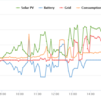- Joined
- 27 Jan 2008
- Messages
- 27,674
- Reaction score
- 3,349
- Location
- Llanfair Caereinion, Nr Welshpool
- Country

OK I see your point. Since buying the system they have said my battery is not big enough, by 11 pm most days it is discharged to the amount set when on grid, there is a lower amount should the grid supply fail. So on grid failure I have 7% of 3.5 kWh to keep freezers and central heating running until the sun comes out.It seems to me you have already bought solar panels, an inverter, a battery storage system with some form of islanding controller, and an iBoost to make use of your free energy, and you are now asking whether it is worth the money to buy the correct immersion heater to make the energy savings work. Seems like a no-brainer to me.
So 10% of the battery is normally not used. So I want to use solar rather than give it to the grid at 9 p per unit, so in real terms gain 29 p per unit if I use it rather than export it as I pay 38 p for electric from the grid.
Well as far as iboost+ goes really saving oil rather than electric so hard to put a figure on that.
However now I have removed the times that the oil boiler runs to heat my DHW, to switch it back on manually not something I am likely to do. Wash hands in cold water is more likely.
So now really stuck with the iboost+ but as to if a new immersion would pay for itself not so sure, (or indecisive) hence my questions, aimed at other who have preceded me in stalling solar panels. Ask me in a years time and I will have the answers, but as it stands, not a clue if worth some upgrade.
Had the reset not tripped I would have weighted, and decided best option in a years time, but the trip worries me, and I really need to replace the thermostat, so just thermostat, or immersion and thermostat?
So I need to get my head around how an immersion heater works. Today 0.46 kWh has been used to get tank up to temperature set. If I now get three dull days, will I still have hot water on day 3? If the answer is yes, then existing system is good enough, in summer unlikely to get more than 3 dull days, in winter central heating running so not an issue.
Since it tripped out, I don't know if it lasted three days. The iboost+ shows kWh saved, which translated to kWh used to heat water, but I have no idea when it tripped.
I have clearly spent a lot of money around £11k and want a return, still not sure if it was all worth it, but a rough calculation on extra batteries and it seems unlikely to be worth it. Changing life style as to when dish washer, washing machine, and tumble dryer started likely worth the change.
As to waiting until 10 am for first cup of coffee, forget that. But as it stands 3.7 kWh exported today, this grid today
 shows how I have exported energy which it would have been better if I had used. But 38 - 9 = 29 p a unit wasted by exporting. Seems unlikely I will export enough to make using more to heat water worth while.
shows how I have exported energy which it would have been better if I had used. But 38 - 9 = 29 p a unit wasted by exporting. Seems unlikely I will export enough to make using more to heat water worth while.